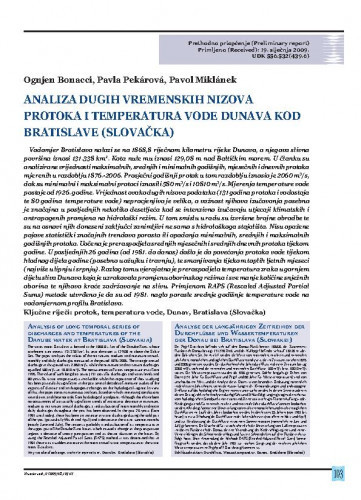Vodomjer Bratislava nalazi se na 1868,8 riječnom kilometru rijeke Dunava, a njegova slivna površina iznosi 131.338 km2. Kota nule mu iznosi 129,08 m nad Baltičkim morem. U članku su analizirane vrijednosti maksimalnih, srednjih i minimalnih godišnjih, mjesečnih i dnevnih protoka mjerenih u razdoblju 1876.-2006. Prosječni godišnji protok u tom razdoblju iznosio je 2060 m3/s, dok su minimalni i maksimalni protoci iznosili 580 m3/s i 10810 m3/s. Mjerenja temperature vode postoje od 1926. godine. Vrijednost ovako dugih nizova podataka (131 godina protoka i vodostaja te 80 godina temperature vode) neprocjenjivo je velika, a važnost njihova izučavanja posebno je značajna u posljednjih nekoliko desetljeća kad se intenzivno izučavaju utjecaji klimatskih i antropogenih promjena na hidrološki režim. U tom smislu u radu su izvršene brojne obradbe te su na osnovi njih doneseni zaključci zanimljivi ne samo s hidrološkoga stajališta. Nisu opažene pojave statistički značajnih trendova porasta ili opadanja minimalnih, srednjih i maksimalnih godišnjih protoka. Uočena je preraspodjela srednjih mjesečnih i srednjih dnevnih protoka tijekom godine. U posljednjih 26 godina (od 1981. do danas) došlo je do povećanja protoka vode tijekom hladnog dijela godine (posebno u ožujku i travnju), te smanjivanja tijekom toplih ljetnih mjeseci (najviše u lipnju i srpnju). Razlog tomu vjerojatno je preraspodjela temperatura zraka u gornjem dijelu sliva Dunava koja je uzrokovala promjenu oborinskog režima i sve manje količine snježnih oborina te njihovo kraće zadržavanje na slivu. Primjenom RAPS (Rescaled Adjusted Partial Sums) metode utvreno je da su od 1981. naglo porasle srednje godišnje temperature vode na vodomjernom profilu Bratislava..; The water meter Bratislava is located at the 1868.8 r. km of the Danube River, whose catchment area covers 131,338 km2. Its zero elevation is 129.08 m above the Baltic Sea. The paper analyzes the values of the maximum, medium and minimum annual, monthly and daily discharges measured in the period 1876-2006. The average annual discharge in this period was 2,060 m3/s, while the minimum and maximum discharges equalled 580 m3/s i.e. 10,810 m3/s. The measurements of water temperature exist from 1926. The value of such long data series (131 years for discharges and water levels and 80 years for water temperature) is invaluable, while the importance of their studying has been particularly significant in the past several decades of intensive studies of the impacts of climatic and anthropogenic changes on the hydrological regime. In view of this, the paper contains numerous analyses, based on which interesting conclusions were drawn, and these not only from hydrological standpoint. Although there have been no occurrences of statistically significant trends of increase or decrease in minimum, medium or maximum annual discharges, a redistribution of mean monthly and mean daily discharges throughout the year has been observed. In the past 26 years (from 1981 until today), there has been an increase in water discharge during the cold part of the year (particularly March and April) and a decrease in the warm summer months (mostly June and July). The reason is probably a redistribution of air temperatures in the upper part of the Danube River basin, which caused a change in the precipitation regime, a decrease of snowy precipitation and its shorter duration in the basin. By using the Rescaled Adjusted Partial Sums (RAPS) method, it was determined that in 1981 there was a sudden increase in the mean annual water temperatures at the water meter Bratislava.
Sažetak
